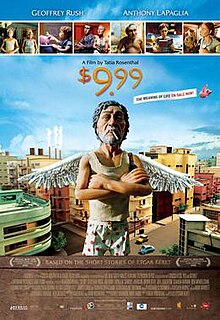$9.99
 Offbeat short story writer Etgar Keret had collaborated twice with clay animator Tatia Rosenthal, supported by the Tisch School of film art at NYU. Her low-budget clumsy clay modelling work for Crazy Glue and A Buck's Worth gave early signs of talent, clearly inspired by Keret's blackly comic view of urban relationships.
Offbeat short story writer Etgar Keret had collaborated twice with clay animator Tatia Rosenthal, supported by the Tisch School of film art at NYU. Her low-budget clumsy clay modelling work for Crazy Glue and A Buck's Worth gave early signs of talent, clearly inspired by Keret's blackly comic view of urban relationships.
In the mid-2000s, the two Israelis gained backing from their government's film promotion unit and from its counterparts in Australia, federally and in the state of New South Wales. Rosenthal gathered a team of professional animators, and recorded Australian actors' voices at long distance (from New York), for her first full-length (71-minute) feature, $9.99.
Subtitled The Meaning of Life, it blends six of Keret's bizarre and soulful tales in its magically-realistic look at the interlocking lives of a Sydney apartment block's residents. They could of course live in any city, and British TV viewers will see some similarities with the cruder and ruder Crapston Villas. Rosenthal's award-winning clay models are rough-skinned angst-ridden characters, seeking "the meaning of life", the title of a mail-order booklet bought by an unemployed lead character for just $9.99.
His father's accidentally helped a homeless man commit suicide (a reprise of the Buck's Worth anecdote). His brother, a repo man, meets a super-model whose aversion to hair prompts him to shave fully and then invert his skin. One of their neighbours loses his fiancee and finds a trio of beery dropout tiny people in his apartment. The fiancee's a schoolteacher, one of whose pupils lives in the same block and names his piggy bank after an elderly widower living upstairs, who provides accommodation for the homeless man, transformed into an angel with swan wings.
The noirish dark-lit narrative is reminiscent of the work of one master of clay animation, Jan Svankmajer. Full-frontal nudity and slyly-camouflaged sex scenes are brilliantly depicted, and far from the comic satires of Captain America. As a creative director, Rosenthal is also more studiedly dramatic than Nick Park (Oscar-winning more than once for Wallace and Gromit), and her characters are more "human" and impressionistic works of art than Tim Burton's (Nightmare before Christmas, Corpse Bride).
As other DVDs' extras have illustrated, claymation and other slow-motion animation techniques require a lot of time and patient model manipulation. It's craftsmanship that becomes an art in the hands of a well-coordinated corps of professionals, from costumiers to film editors, music composers to lighting engineers.
The animated characters' off-screen voices are crucial, and the Australian connection worked well for the Israeli creative duo. They signed up some star names (Geoffrey Rush, Anthony LaPaglia, Barry Otto, Ben Mendelsohn) that may have helped them gain international distribution. Less fortunately, the 2008 movie was eclipsed only a year later when Australia's own Mary and Max claymation movie (from Oscar-winning Adam Harvey Krumpet Elliot) opened to even greater acclaim and an Oscar short-list nomination. Although $9.99 is very good and arouses chuckles and contemplation, it's out-classed both for screenplay and animation. To be fair, it's in a different class of claymation artistry, and it warrants further feature-making.

0 comments:
Post a Comment